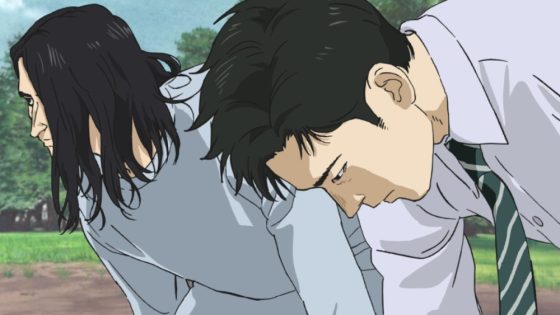Japanese director Kenji Iwaisawa‘s debut feature “On-Gaku: Our Sound” was a hit at the 2020 Annecy Animation Festival, where it played in the festival’s Contrechamp competition and won best original music. This year, the filmmaker returns to Annecy to present his next film, “Hyakuemu.”, in a dedicated Annecy Work in Progress session.
Based on the original manga “Chi: Chikyū no Undō ni Tsuite” by Uoto, the film tells the story of Togashi, a child born to run. The boy wins every 100-meter race with little effort. In sixth grade, a transfer student named Komiya arrives with loads of motivation but little technical skill. Togashi begins training with his new classmate, who gives him a new purpose: to win at all costs. Years later, the two meet as rivals on a racetrack.
“Hyakuemu.” is produced by Pony Canyon, Asmik Ace and the Tokyo Broadcasting System. Iwaisawa’s Rock’ N Roll Mountain is animating the feature, which is well into production and scheduled for a theatrical release in 2025.
This year’s Annecy WIP panel will be attended by Iwaisawa along with the film’s art director Keikankun Yamaguchi, animation director and character designer Keisuke Kojima, and Asmik Ace producer Akane Taketsugu.
“Hyakuemu” will be Iwaisawa’s second feature. His third, “Hina is Beautiful,” is already in the works and was a hot title at the Marché du Film’s Annecy Animation Showcase in 2023 and is scheduled to wrap in 2026.
Ahead of this week’s Work in Progress presentation, Iwaisawa spoke with Variety about his new project, working with different aesthetics, and delegating responsibilities. He also shared some exclusive first-look artwork from the film.
Kenji Iwaisawa
How important is it for Japanese productions to participate in events like Annecy and have this kind of exposure in the West while still in development or production?
Iwaisawa: I think it is an important place to make a direct appeal to countries other than Japan.
Making ‘On-Gaku,’ you filled seven roles, including writer, director, and animator. Are you doing so much on this film?
“On-Gaku: Our Sound” was a truly individual production, so I played many different roles. For example, I believe that the students who submit works to the Graduation Films categories at Annecy also play multiple roles. This is also true of short films. “On-Gaku: Our Sound” is a feature film that was made in the same way as a short. Because I made the film in that way, I found myself playing several roles.
On the other hand, this time, I can concentrate on being the director because “Hyakuemu.” is being produced as a feature film. When I created “On-Gaku: Our Sound,” the director’s job was the one I was least able to do because I had to do other things as well. With “Hyakumemu.,” I finally feel like I can take on the role of director.
The pictures we’ve seen for ‘Hyakuemu.’ are more detailed and realistic than those from ‘On-Gaku.’ Can you talk a bit about the aesthetic differences audiences will see in this film?
When I made short films, my style was always to draw in detail, so for “On-Gaku: Our Sound,” I kept it simple to match the original work. “On-Gaku” is a more unusual style for me, but since it was my debut work that was released first, people may have the impression that my style has changed a lot with “Hyakuemu.” In fact, I think the look in “Hyakuemu.” is closer to my own style.
I’m quite conscious of the visuals/aesthetics. I think character design is extremely important. Character design is the first thing the audience will see, so I’m very careful about things like the balance of the characters’ proportions. Also, rather than the so-called orthodox visuals of Japanese anime, it’s more like live-action, or somewhere in between.
Like ‘On-Gaku,’ this film takes place in a school setting. What is it about that world that is appealing to you as a storyteller?
I’ve never really thought about it. In Japan, youth films are often set in schools, but that might be unusual overseas. Rather than me having a particular preference, both films were based on original works, and when I chose them, they were set in schools. It’s not that I consciously chose to make films set in schools.

“Hyakuemu.”
©Uoto, Kodansha/Hyakuemu. Film Partners

“Hyakuemu.”
©Uoto, Kodansha/Hyakuemu. Film Partners

“Hyakuemu.”
©Uoto, Kodansha/Hyakuemu. Film Partners
Source Agencies


